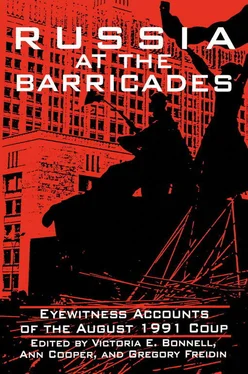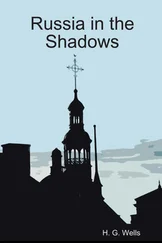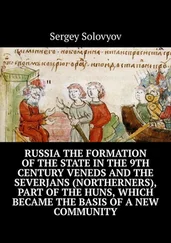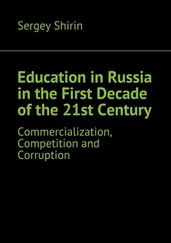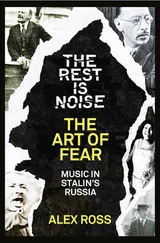Interview with Yevgenii Shaposhnikov, “The Coup and the Armed Forces,” Nezavisimaia gazeta , September 12, 1991.
Interview with Anatolii Sobchak, “The Breakthrough: The Coup in St. Petersburg,” Moscow News , August 26, 1991.
Interview with Aleksandr Yakovlev, “Our Children Were on the Barricades,” Ogonëk , no. 36 (August 31–September 7, 1991).
Interview with Aleksandr Prokhanov, “Defenders of the White House,” Komsomolskaia pravda , September 3, 1991.
Michael Hetzer, “Death on the Streets,” Guardian , August 23, 1991.
“A Man in the Crowd,” Ogonëk , no. 41 (October 5–12, 1991).
Iain Elliot, “Three Days in August: On-the-Spot Impressions,” RFE/RL Research Institute, Report on the USSR , vol. 3, no. 36 (September 6, 1991).
Interview with Tatiana Malkina, “The August 19 Press Conference,” Ogonëk , no. 41 (October 5–12, 1991).
Photo Credits
Cover illustration and photographs on pages 80, 87, 89, 96, 97, 103, 174, and 250courtesy of the PhotoGroup of the White House Defenders (PhotoArt, Moscow).
Photographs on pages 73, 75, 76, 82, 94, 99, 102, and 105by Gregory Freidin. Photographs on pages 90, 91, 92, and 98by Victoria E. Bonnell and Sandor Szabo.
Photograph on page 140by Donald J. Raleigh.
Photographs on pages 150, 152, and 156courtesy of Vladimir Zavorotnyi.
Note on Transliteration and Interpolations
We follow the Library of Congress system for transliterating Russian words into English, but have made some exceptions in the interest of readability. Throughout, we have omitted soft signs, and we use a “Y” to begin such names as Yakovlev, Yevtushenko, and Yurii. More generally, we have adopted the New York Times usage for well-known names, titles, and places.
The reader will also note that we have used two different conventions for interpolations into the text. If the interpolation is by the author or interviewee, it appears in parentheses. If it was made by the editors for the purpose of clarification or identification, it appears in square brackets.
The explanatory footnotes that appear in the volume were supplied by the editors.
The following Russian media are mentioned in the book under their Russian names. English translations of these titles are as follows:
Periodicals
Argumenty i fakty (Arguments and Facts)
Den (Day)
Izvestiia (Information)
Kommersant (Man of Commerce)
Kommunist (Communist)
Komsomolskaia pravda (Komsomol Truth)
Kuranty (Chimes)
Literaturnaia gazeta (Literary Gazette)
Literaturnaia Rossiia (Literary Russia)
Magnitogorsk rabochii (Magnitogorsk Worker)
Moskovskii komsomolets (Moscow Komsomol Member)
Moskovskie novosti (Moscow News)
Moskovskaia pravda (Moscow Truth)
Nevskoe vremia (Neva Times)
Nezavisimaia gazeta (Independent Gazette)
Obshchaia gazeta (Joint Gazette)
Ogonëk (Flicker)
Pravda (Truth)
Rossiia (Russia)
Rossiiskaia gazeta (Russian Gazette)
Rossiiskie vesti (Russian News)
Smena (New Generation)
Stolitsa (The Capital)
Vecherniaia Moskva (Evening Moscow)
News Agencies
TASS (Telegrafnoe agenstvo Sovetskogo Soiuza): the official news agency of the Soviet Union
ITAR-TASS (Informatsionnoe telegrafnoe agenstvo Rossii–TASS): the Russian wire service–TASS
RIA (Rossisskoe informatsionnoe agenstvo, or Russian Information Agency): the official news agency of the RSFSR
Novosti: semi-official news agency of the USSR
Interfax: an independent news agency
Postfactum: an independent news agency
Introduction
VICTORIA E. BONNELL AND GREGORY FREIDIN
The events of August 1991 can best be understood as a consequence of the reform program put into motion by Mikhail Gorbachev and his closest allies, Aleksandr Yakovlev and Eduard Shevardnadze, following Gorbachev’s appointment as General Secretary of the Communist Party of the Soviet Union in March 1985. Recognizing that the country faced severe and intractable economic and social problems that had long been neglected, Gorbachev and his team embarked on a series of fundamental reforms of the Soviet system. In a December 1988 meeting with U.S. President George Bush, Gorbachev described his intentions:
You’ll see soon enough that I’m not doing this for show and I’m not doing this to undermine you or to surprise you or to take advantage of you. I’m playing real politics. I’m doing this because I need to. I’m doing this because there’s a revolution taking place in my country. I started it. And they all applauded me when I started it in 1986 and now they don’t like it so much, but it’s going to be a revolution, nonetheless. [1]
Experts disagree as to how much of Gorbachev’s revolutionary program should be attributed to his team’s original plans and how much to the unanticipated consequences of the initial reforms. [2]But few would deny that the changes that took place were significant and far-reaching. The introduction of glasnost —a policy of increasing openness in the mass media—irrevocably transformed the political culture of the country. Beginning in November 1987, Gorbachev relinquished the Communist Party’s monopoly on truth. Encouraged from above, intellectuals and political activists saw to it that a pluralism of ideas quickly replaced the Leninist idea of a single truth defined by a single party, disseminated by propagandists, and backed up by censorship. By 1990, with the revision of Article 6 of the Soviet Constitution, which had guaranteed the Communist Party’s “leading role” in political and social life, there was virtually no subject that could not be discussed openly in the media or other public forums. Society was now able to challenge the Party’s preeminence on all fronts, and the Party, as was becoming increasingly clear, was not up to the challenge.
In the political sphere, the Gorbachev reforms led to a restructuring— perestroika —of the system of government, which since 1917 had been firmly controlled by the Communist Party. Representative bodies, from local soviets to the Supreme Soviet of the USSR, were staffed in single-candidate elections and functioned as rubber stamps for decisions taken at the higher echelons of the Communist Party apparatus. Gorbachev revamped these pseudo-democratic institutions. His first major innovation was the creation of the USSR Congress of People’s Deputies as a national assembly that would select the standing legislature—the Supreme Soviet—from among its members. Two-thirds of the deputies to the new Congress were chosen in elections in the spring of 1989, and—in a radical break with the Communist past—many of these were free elections with competing candidates. The remainder of the deputies were selected by so-called “public organizations,” including such stalwarts of the old regime as the “official” trade unions and, of course, the Communist Party. (Gorbachev himself chose to become a deputy not by election, which he could easily have won, but through the Communist Party quota—a decision that deprived him of any popular mandate, with fateful consequences for his future in politics.) Similar legislative institutions were then created at the republic level (elections for Russia’s Congress of People’s Deputies took place in 1990), and, for the first time, genuine elections for local soviets were held in cities throughout the country.
Читать дальше
